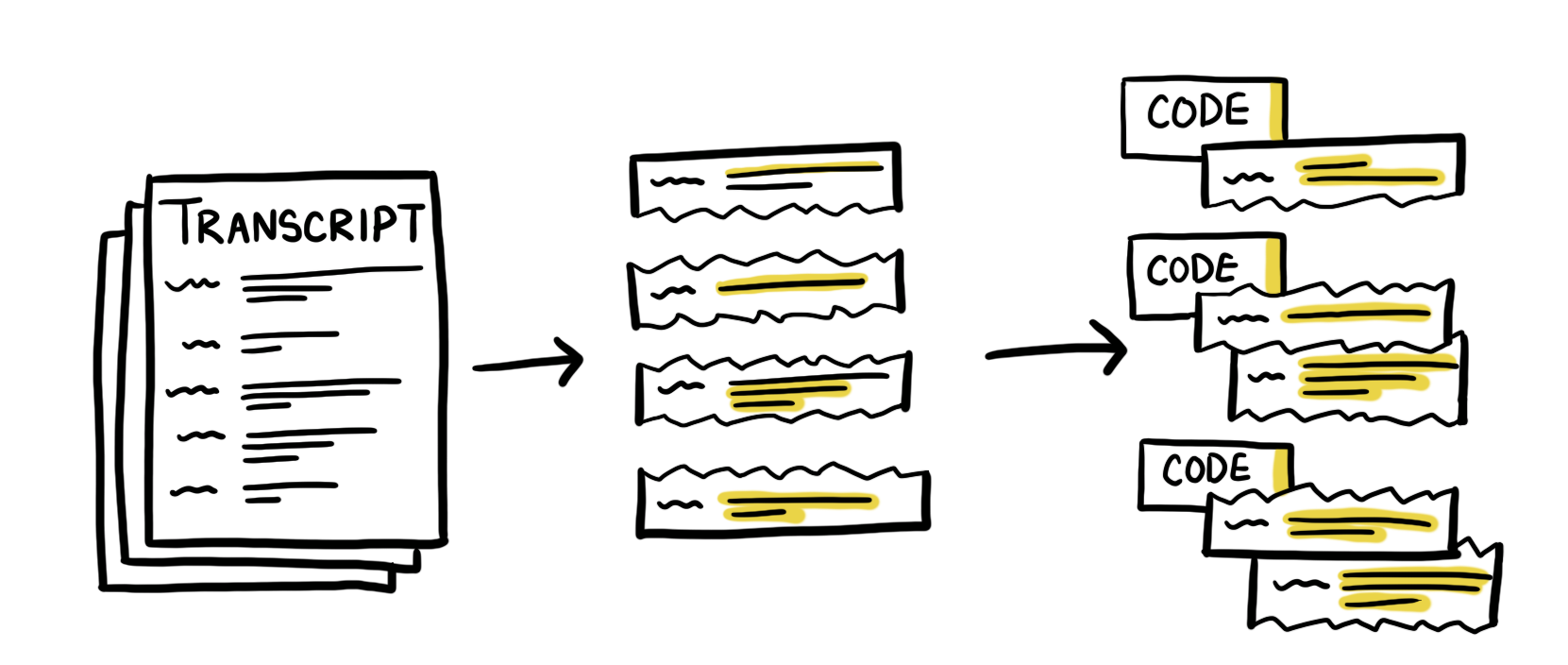The Guide to Qualitative Methods of Research
What is Qualitative Research? | Methodologies | Data Collection Methods | Analysis Approaches | Qualitative Coding | Using Qualitative Analysis Software | Start Free Qualitative Data Analysis Course
What is Qualitative Research?
Qualitative research is research that utilizes non-numerical methods such as observations, in depth interviews, or focus groups. It can also involve analyzing content such as documents or records. Qualitative analysis deals with words, meaning, and interpretation.
Qualitative Research Methodologies
There are various approaches to qualitative methodologies, each with different perspectives, strengths and weaknesses.
Grounded Theory
Develop a new theory derived from data
Grounded theory is a qualitative method where you develop new theories based on the collection and analysis of real world data. Data collection, data analysis, and theory development occur iteratively. Iterative data collection and analysis occurs until you reach theoretical saturation: the point at which additional data adds no additional insight into your new theory.
Read more about grounded theory.
Narrative Research
Learn how stories are told
Researchers use narrative analysis to understand how research participants construct story and narrative from their own personal experience. That leads to dual layer of interpretation. First the research participants interpret their own lives through narrative. Then the researcher interprets the construction of that narrative.
Narrative analysis, like many qual methods, takes a set of data like interviews and reduces it to abstract findings. The difference is that while many popular qualitative methods aim to reduce interviews to a set of core themes or findings, narrative analysis aims to reduce interviews to a set of core narratives.
Read more about narrative research.
Action Research
Use research to drive change
With Action Research, researchers and participants collaborate to understand underlying issues, problems, and weaknesses in institutions or systems and act on their research findings to create real world change.
Read more about action research.
Ethnography
Learn through cultural immersion
Ethnographic research involves on the scene learning and observation. Researchers study their participants’ culture and behavior by immersing themselves in the community. Ethnography enables a deep study of behavior, and enables researchers to learn conventions and social dynamics.
Phenomenological research
Explore the participants’ point of view
Phenomenological research involves learning about the lived experience of participants from their perspective. Phenomenological research looks to set aside the researcher’s biases, assumptions, and perspective on the situation.
Qualitative Data Collection Methods
In Depth Interview
Learn from multiple people through one on one interviews
For in depth interviews, the interviewer interviews a series of participants one on one to explore behaviors, description, and motivations. In preparation for the interviews, the researcher will create a discussion guide.
Semi-structured interviews
Start with a discussion guide, but be free to go off script
Similar to in-depth interviews, interviewers will prepare a research discussion guide for semi-structured interviews. However they will allow flexibility in the interview to go off-script. This allows for a balance between the structure of standardized questions, while allowing the interviewee to take the interview beyond the semi structured interview questions on the discussion guide.
Learn more about semi-structured interviews.
Focus Groups
Learn through group discussions
Focus groups are group discussions with participants in a target audience, led by a moderator. Focus groups are commonly used in market research for gathering feedback on product launches, marketing campaigns, service designs, or other concepts. They are also popular for political research.
Stakeholder interviews
Learn from your research stakeholders
Stakeholder interviews are in depth interviews or semi structured interviews held with the stakeholders of your research. If you work with a research advisor, client, or team members with a vested interest in the outcome of your research, these are your stakeholders. You learn from stakeholders to optimize the success of your research.
Case Study
Study a person or group in depth
A case study is an in depth research approach to understand one particular person or group in their real life context. You use a variety of data collection methods such as in depth interviews, ethnography and observation to pull together a case study of a particular phenomenon and the context around it. A popular example of case studies are the Harvard Business Case Studies. It’s often used to understand a complex, multi-faceted phenomenon.
Qualitative Observation
Go on location and observe with your senses
Qualitative observation is a research method in which researchers collect data using their five senses, sight, smell, touch, taste, and hearing. It is a subjective method of gathering information as it depends on the researcher’s sensory organs. This approach does not involve quantitative measurement; it only deals with data you can observe with your senses.
Learn more about qualitative observation.
Qualitative Surveys
Gather data using structured questions
Qualitative surveys are a structured way to gather information from participants by using open ended questions that elicit long form written, typed, or recorded responses. Surveys can be used to learn about the opinions, narratives, feedback, or attitudes of participants.
Secondary Research
Compile knowledge from other sources
Secondary research involves compiling knowledge from other data sources such as documents, published papers, libraries, websites, or data repositories. This is a resourceful way to gather information if you do not have the resources to collect first hand information. There are many resources online for gathering secondary research.
Try Delve, Software for Qualitative Coding
Online qualitative research software such as Delve can help streamline how you anlayze your qualitative coding. Try a 14 day free trial of Delve.
Qualitative Data Analysis Methods
You can analyze qualitative data with a variety of approaches. Some approaches, such as content analysis, are deductive. You start with a pre-existing framework or set of codes and see how data fits it. This is a more structured and rigid way to analyze data.
Content analysis
Analyze deductively with an existing framework
Qualitative content analysis is a research method used to analyze and interpret the content of textual data, such as written documents, interview transcripts, or other forms of communication. It provides a systematic way to identify patterns, concepts, and larger themes within the data to gain insight into the meaning and context of the content.
Read more about content analysis.
Thematic Analysis
Analyze inductively by deriving themes from data
Thematic analysis is an inductive qualitative data analysis method that involves deriving themes from data. You start by reading through a data set (such as transcripts from in depth interviews or focus groups), and identifying patterns in meaning across the data to derive themes.
Read more about thematic analysis.
Discourse Analysis
Analyze the meaning of language
Discourse analysis is a blanket term for a range of qualitative research approaches used in analyzing the use of language in social contexts. Researchers employ these techniques to understand the world by investigating the underlying meaning of what people say and how they say it, whether in face-to-face conversation, documents, non-verbal interaction, or images.
Qualitative Coding
The process of coding qualitative data is an important part of the analytical process of analyzing qualitative research. When you generate data from qualitative methods such as semi-structured interviews, qualitative coding allows you to interpret, organize, and structure your observations and interpretations into meaningful theories. Coding in qualitative research allows you to be reflexive, critical, and rigorous with your findings.
Using Software for Qualitative Data Analysis
Software for qualitative analysis like Delve will make qualitative analysis feel seamless. Once you are ready to analyze your qualitative data, just import your data into Delve, and code your data to keep track of patterns. You can use popular methodologies such as grounded theory, thematic analysis, narrative analysis, and content analysis.
Qualitative analysis doesn't have to be overwhelming
Take Delve's free online course to learn how to find themes and patterns in your qualitative data. Get started here.

References:
Green, J., & Thorogood, N. (2018). Qualitative methods for health research.
Isaacs AN. An overview of qualitative research methodology for public health researchers. International Journal of Medicine and Public Health. 2014;4(4):318-323.
Price, P. C., Jhangiani, R., Chiang, I.-C. A., Leighton, D. C., & Cuttler , C. (2017, August 21). Research methods in psychology. Retrieved April 12, 2022, from https://opentext.wsu.edu/carriecuttler/chapter/qualitative-research/




